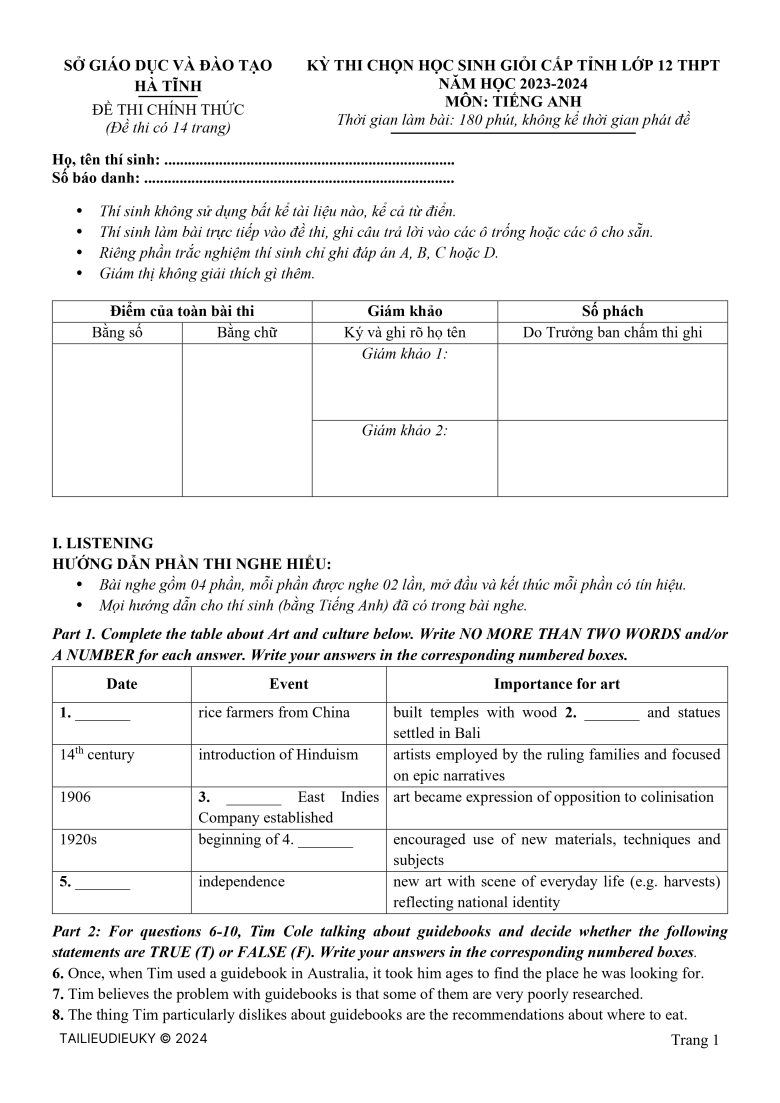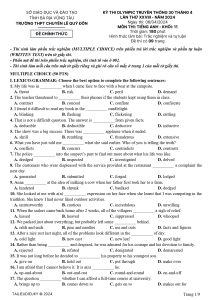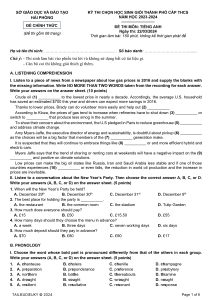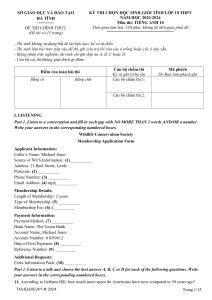Mời quý thầy cô và các bạn học sinh tham khảo Đề thi HSG Tiếng Anh 12 tỉnh Hà Tĩnh năm học 2023-2024 có đáp án và file nghe, có thể tải xuống ở cả định dạng word và pdf tại website Tài liệu diệu kỳ. Đề thi HSG Tiếng Anh 12 được diễn ra vào cuối năm 2023 gồm các câu hỏi Trắc nghiệm và tự luận, kiểm tra các kĩ năng Nghe, Đọc, Viết các thí sinh.
Đề thi chính thức HSG Tiếng Anh 12 tỉnh Hà Tĩnh gồm 14 trang, thí sinh hoàn thành bài thi trong vòng 180 phút.
Đề thi được chia làm 04 phần chính, tổng điểm được tính trên thang điểm 20.
I. Listening (3 điểm):
Part 1: Complete the table about Art and culture; Part 2: True/False statements; Part 3: Multiple choice questions; Part 4: Fill-in-the-blanks
II. Lexico-Grammar (6 điểm):
Part 1: Vocabulary and Grammar Selection; Part 2: Prepositions/Particles; Part 3: Word Formation; Part 4: Synonyms; Part 5: Antonyms; Part 6: Gap Filling
III. Reading (6 điểm):
Part 1: Guided Cloze Test; Part 2: open Cloze Test; Part 3: Reading Comprehension; Part 4: Summary; Part 5: Matching information
IV. Writing (5 điểm):
Sentence tranformations (with keywords) and essay writing.
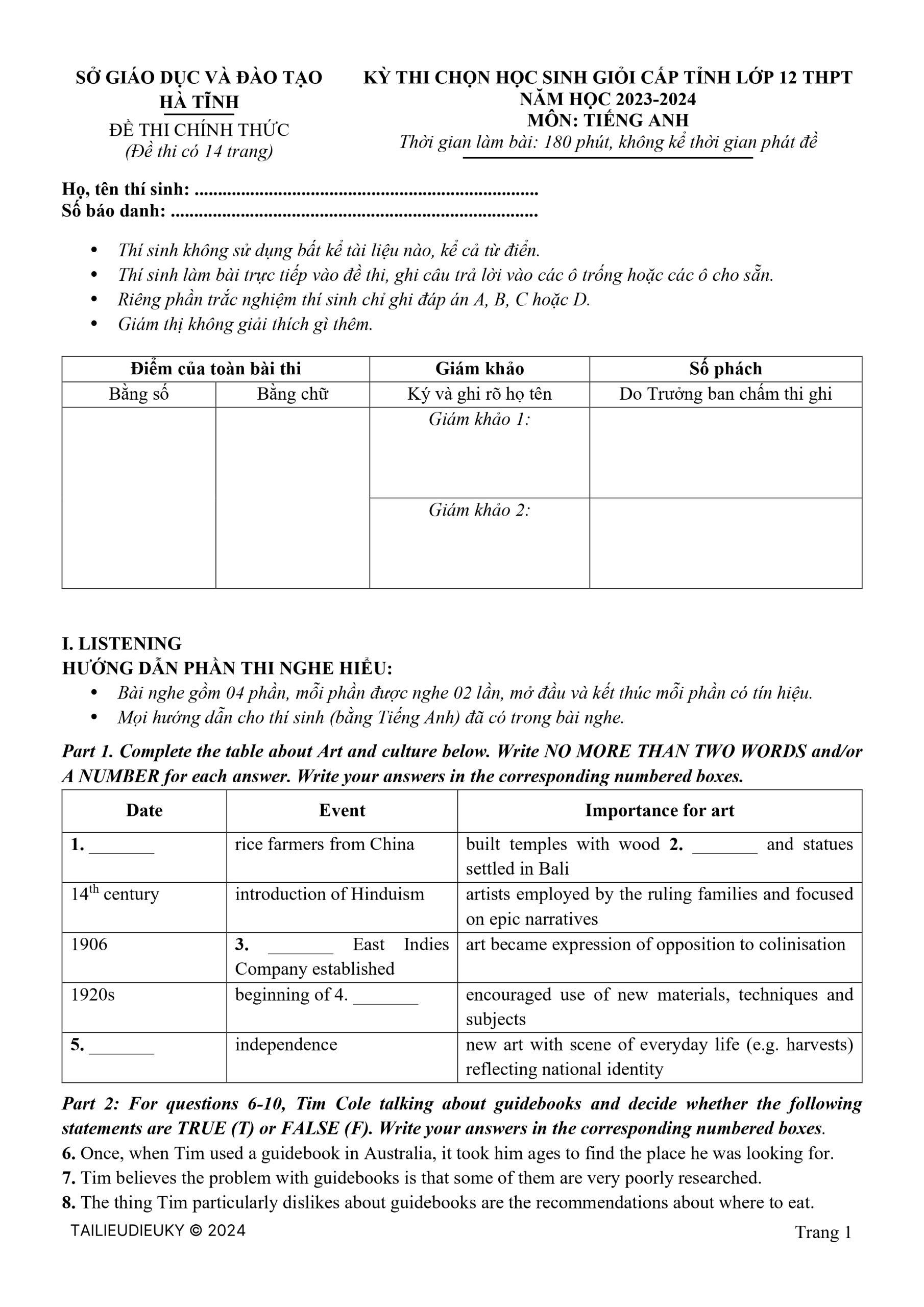
Đề thi HSG Tiếng Anh 12 tỉnh Hà Tĩnh năm học 2023-2024 có đáp án - Trang 1
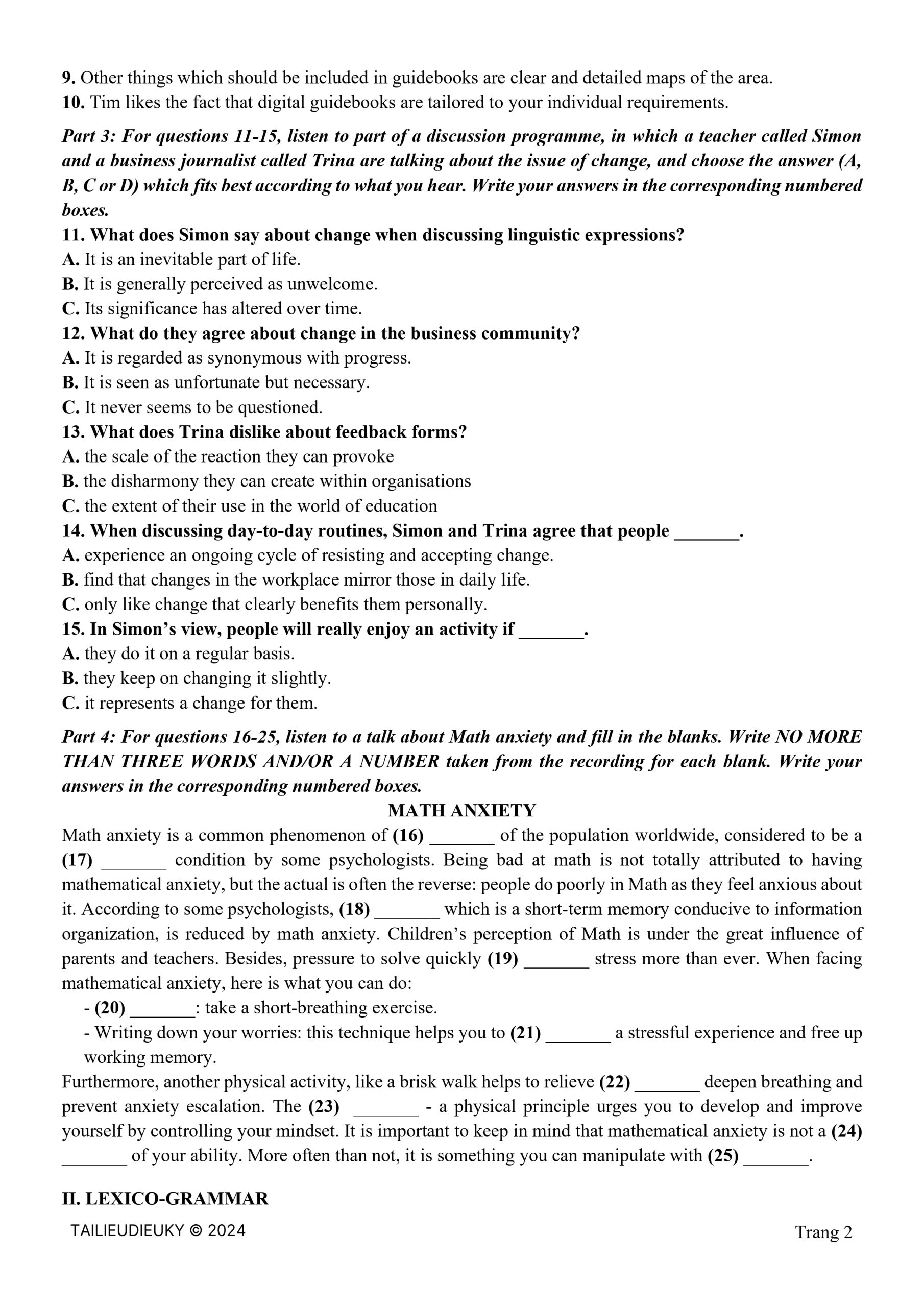
Đề thi HSG Tiếng Anh 12 tỉnh Hà Tĩnh năm học 2023-2024 có đáp án - Trang 2
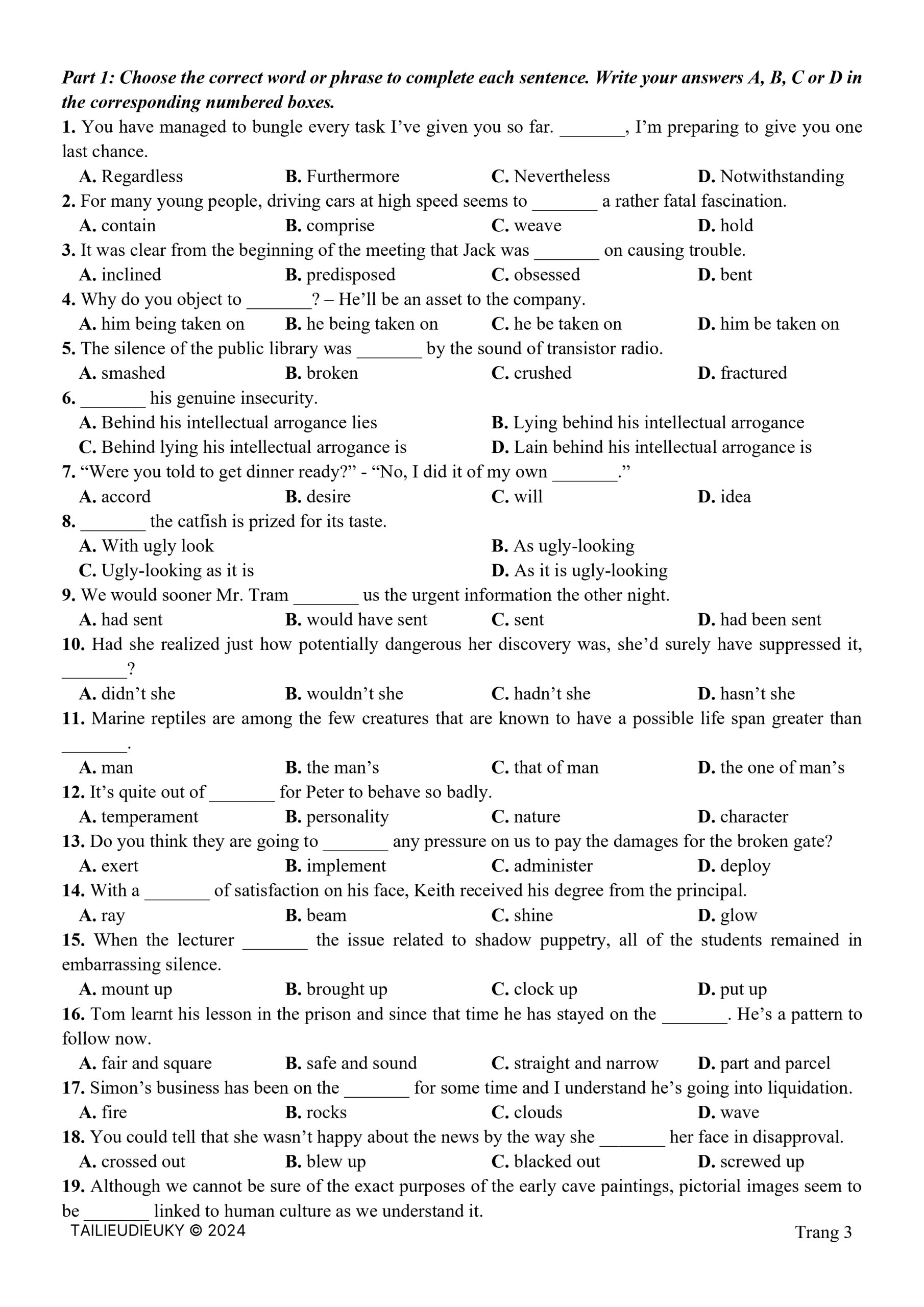
Đề thi HSG Tiếng Anh 12 tỉnh Hà Tĩnh năm học 2023-2024 có đáp án - Trang 3
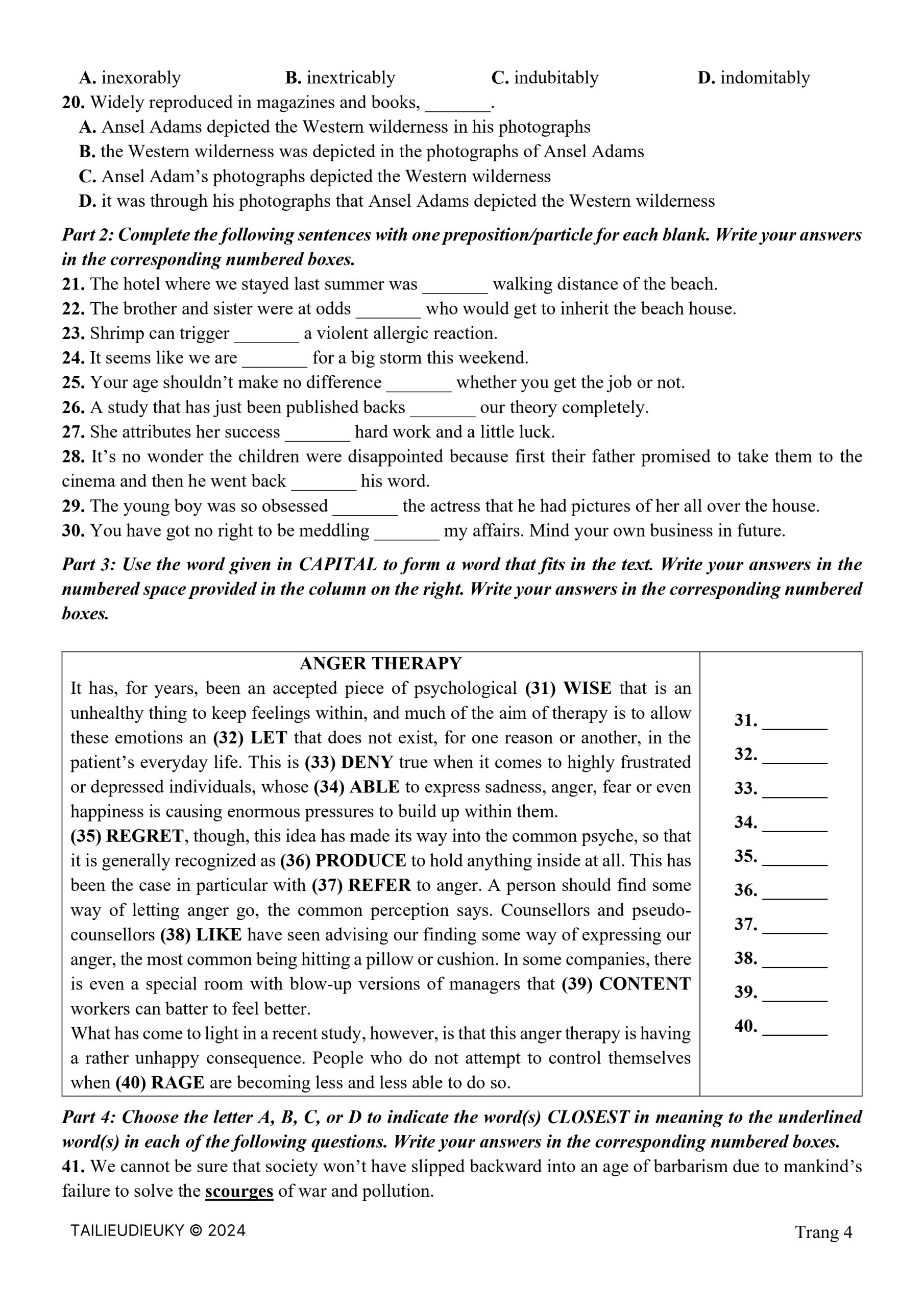
Đề thi HSG Tiếng Anh 12 tỉnh Hà Tĩnh năm học 2023-2024 có đáp án - Trang 4
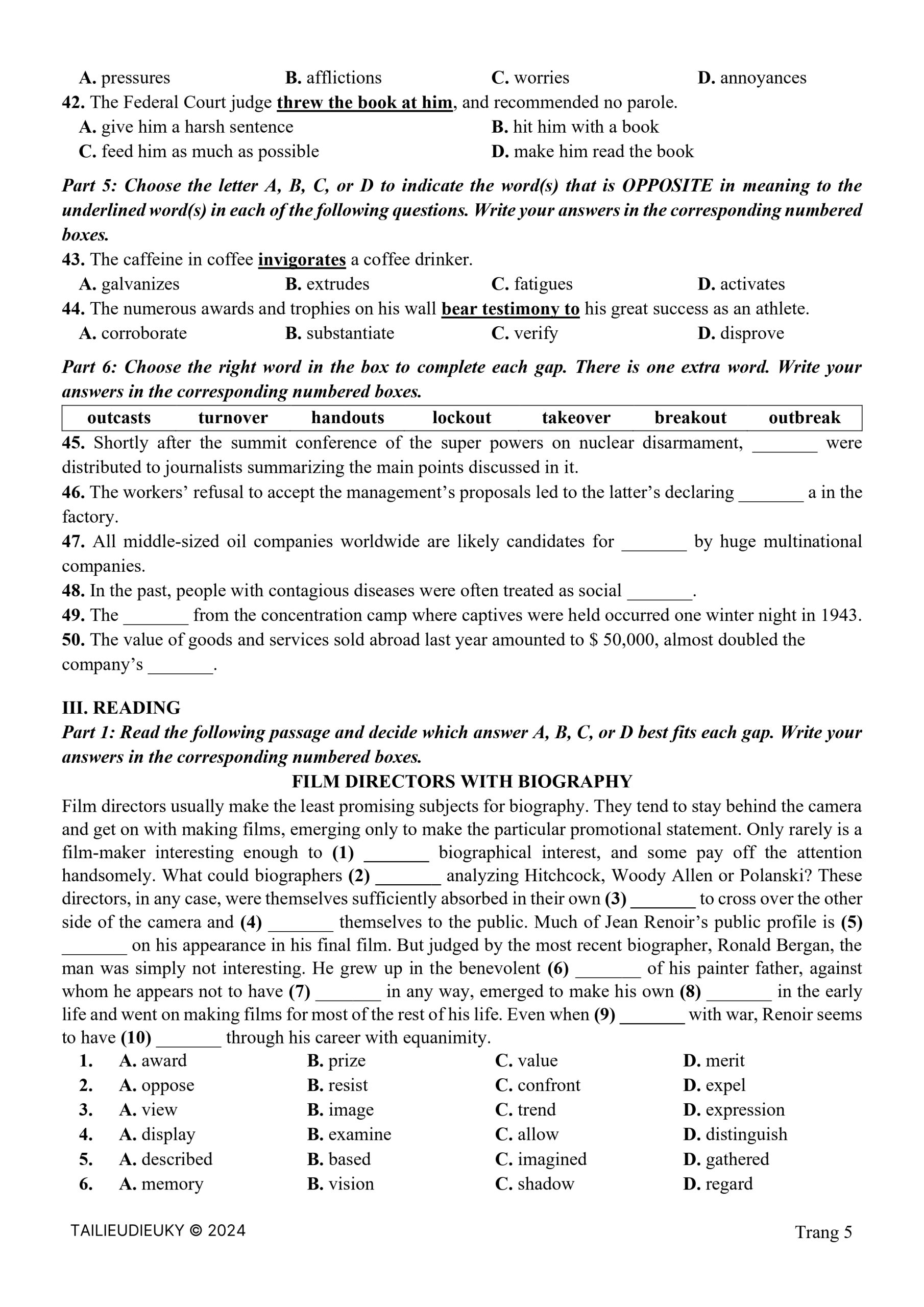
Đề thi HSG Tiếng Anh 12 tỉnh Hà Tĩnh năm học 2023-2024 có đáp án - Trang 5
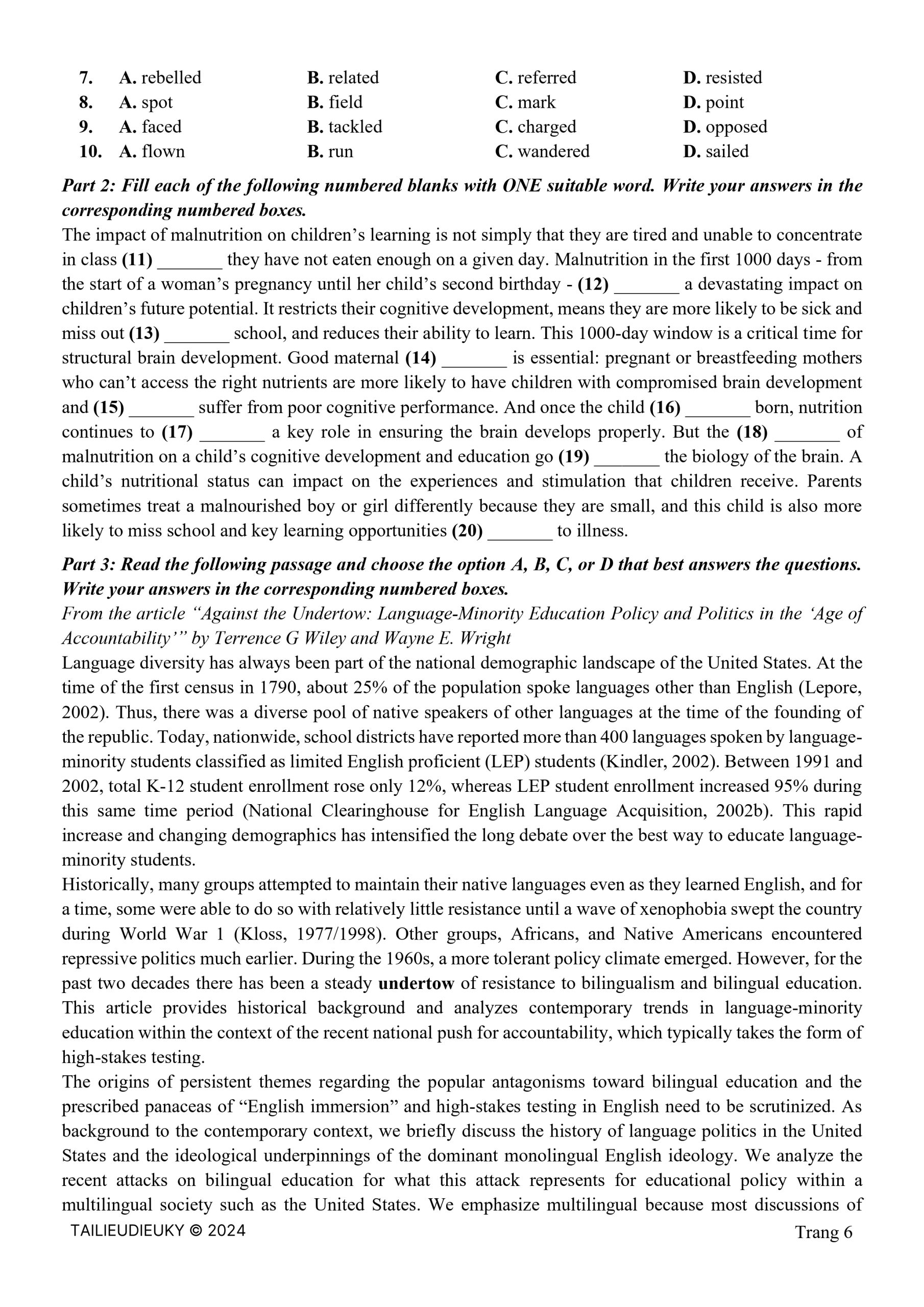
Đề thi HSG Tiếng Anh 12 tỉnh Hà Tĩnh năm học 2023-2024 có đáp án - Trang 6
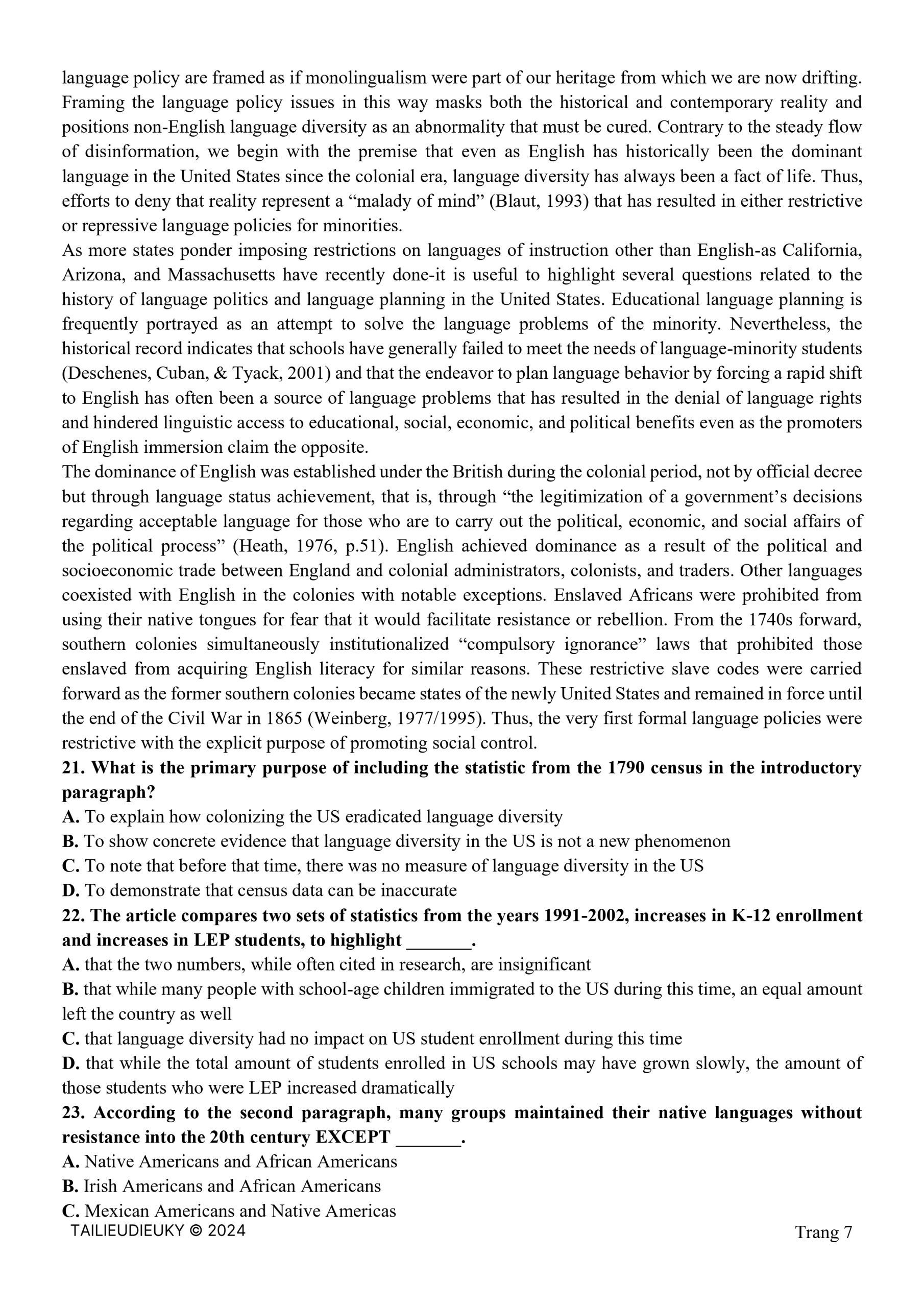
Đề thi HSG Tiếng Anh 12 tỉnh Hà Tĩnh năm học 2023-2024 có đáp án - Trang 7
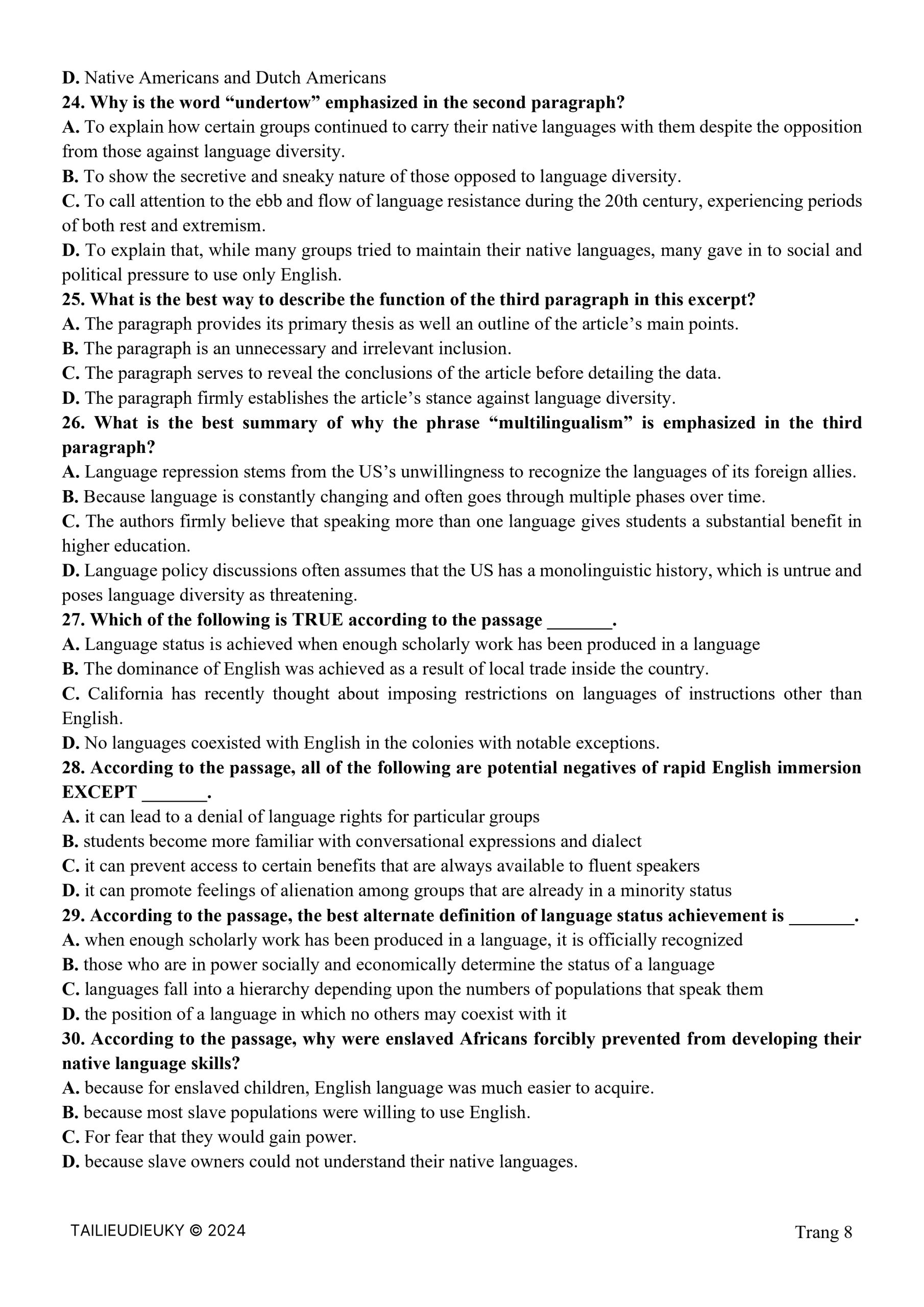
Đề thi HSG Tiếng Anh 12 tỉnh Hà Tĩnh năm học 2023-2024 có đáp án - Trang 8
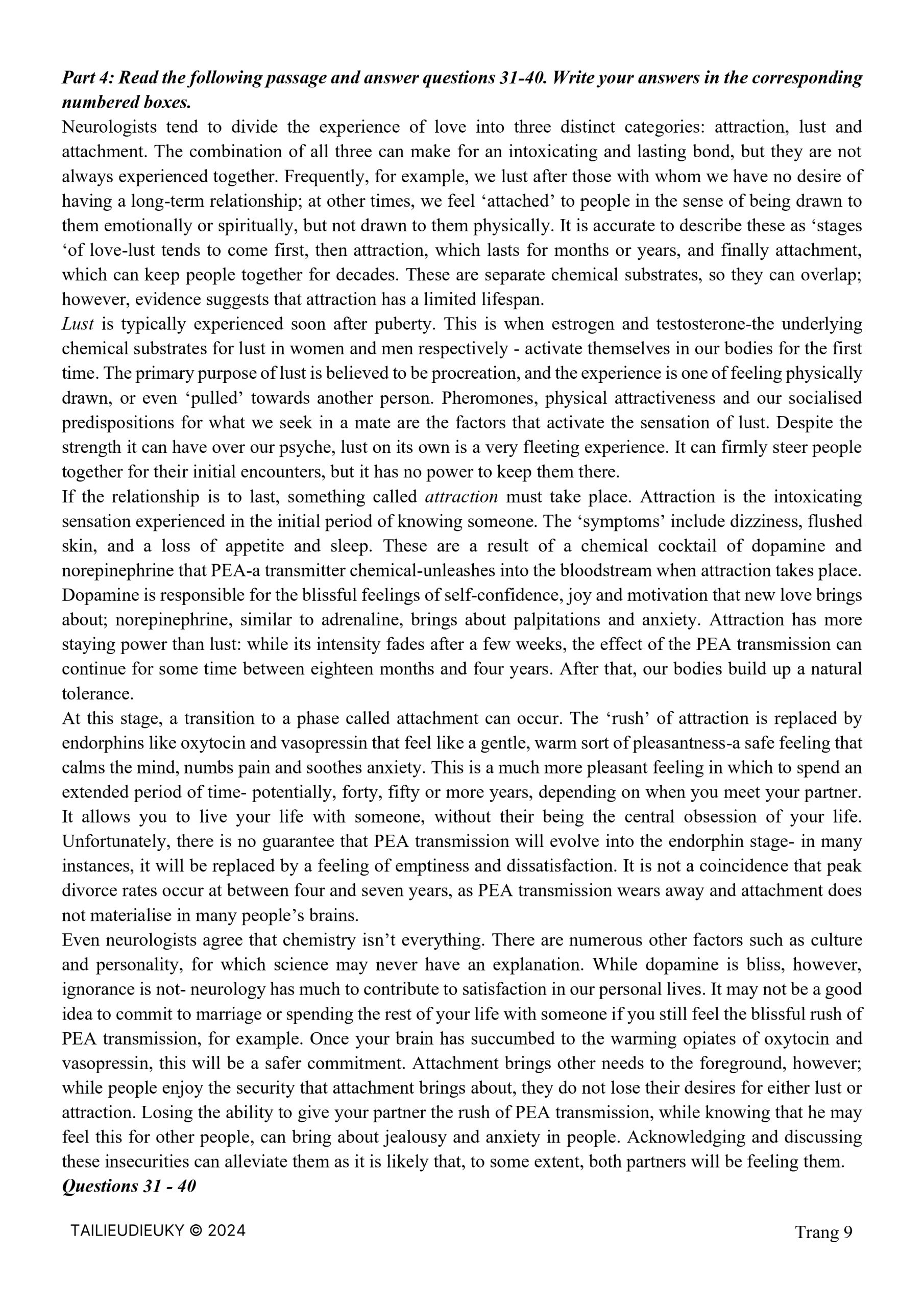
Đề thi HSG Tiếng Anh 12 tỉnh Hà Tĩnh năm học 2023-2024 có đáp án - Trang 9
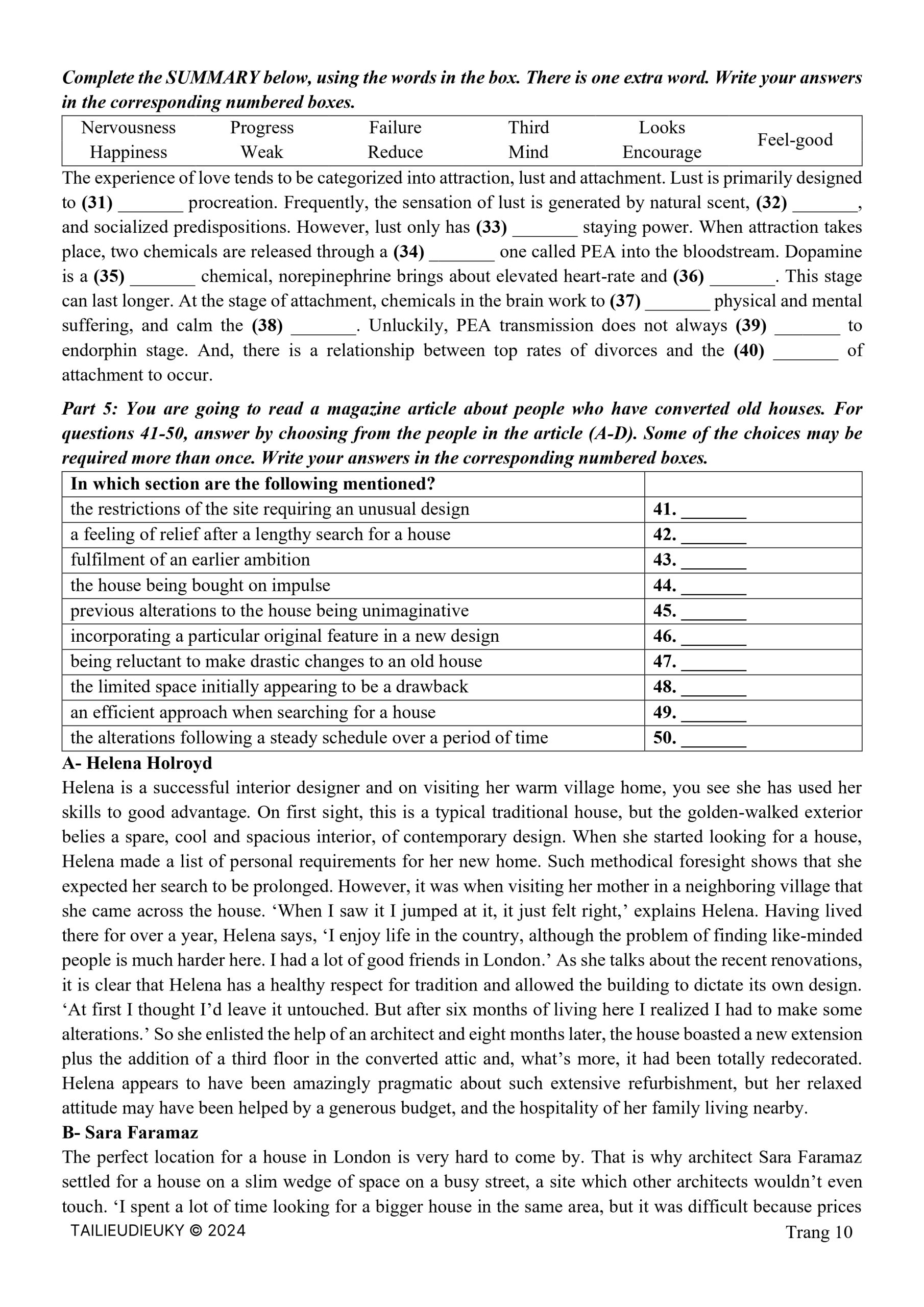
Đề thi HSG Tiếng Anh 12 tỉnh Hà Tĩnh năm học 2023-2024 có đáp án - Trang 10
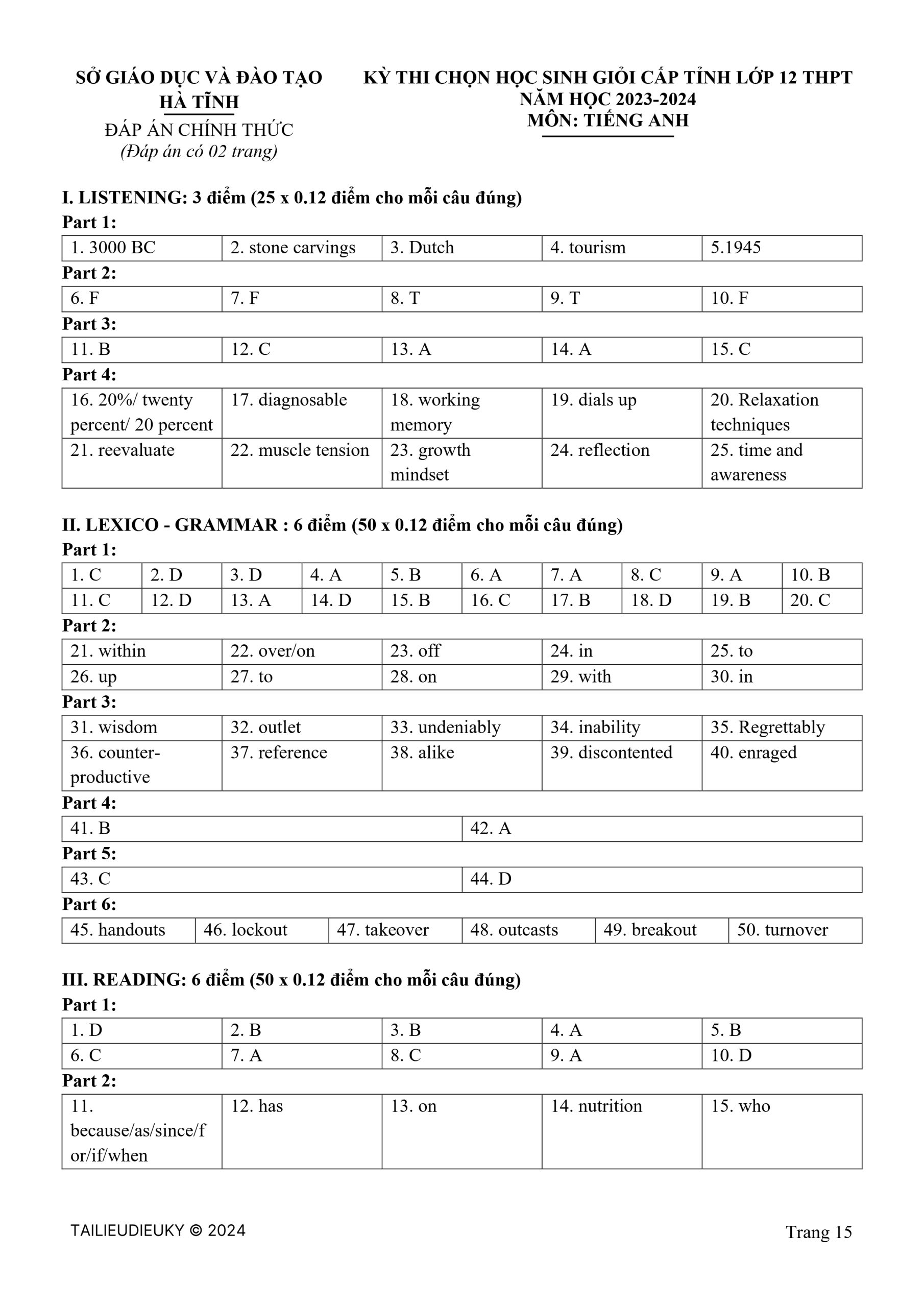
Đáp án chính thức đề thi HSG Tiếng Anh 12 tỉnh Hà Tĩnh năm học 2023-2024 - Trang 1
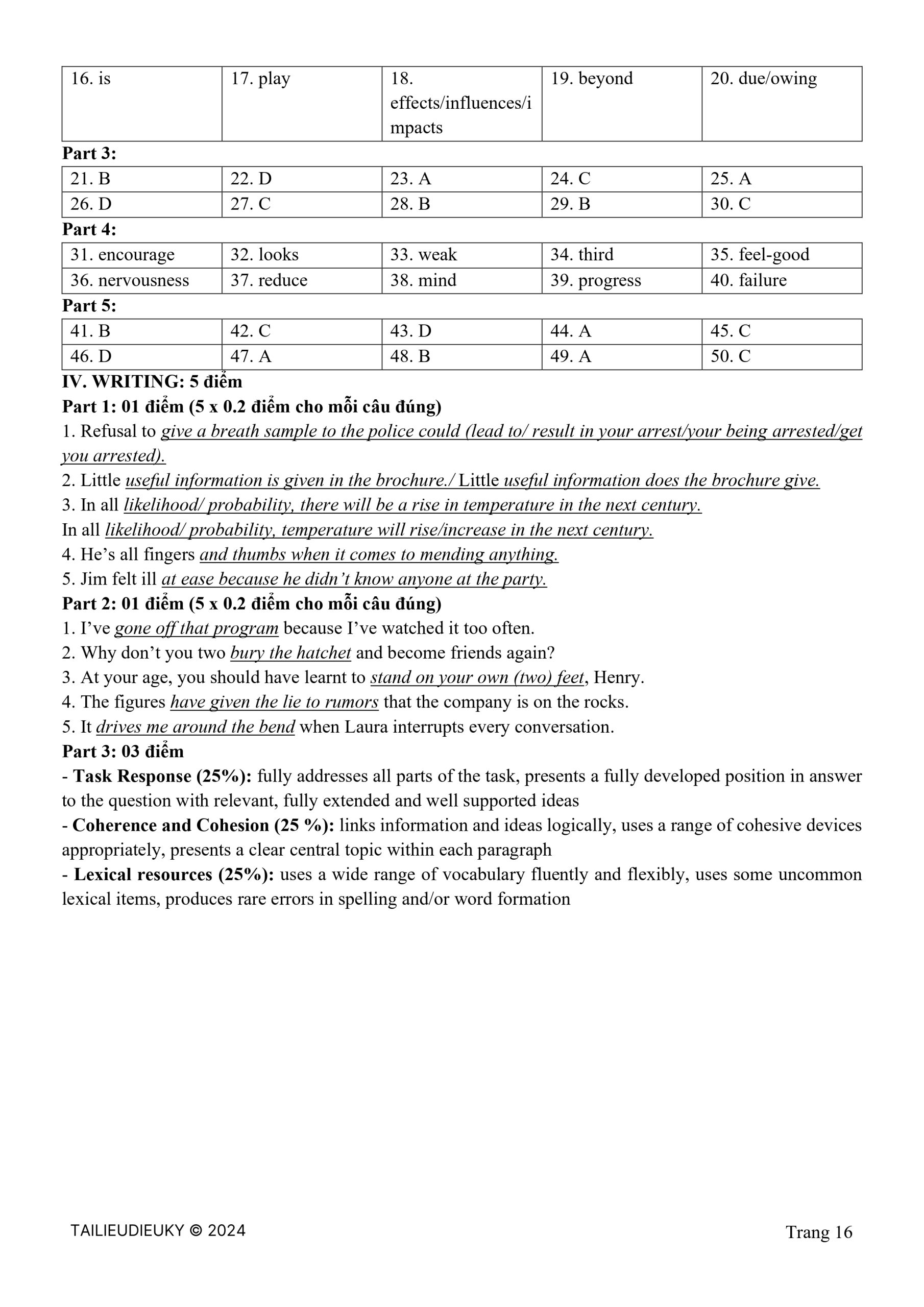
Đáp án chính thức đề thi HSG Tiếng Anh 12 tỉnh Hà Tĩnh năm học 2023-2024 - Trang 2
Ngoài ra để phục vụ công tác bồi dưỡng và ôn luyện cho Kỳ thi chọn học sinh giỏi lớp 12 THPT cấp tỉnh, thầy cô và các bạn có thể tham khảo thêm [Danh mục HSG Tiếng Anh 12] tại website để tham khảo và cập nhật những tài liệu và đề thi mới nhất.
Trích dẫn nội dung Đề thi HSG Tiếng Anh 12 tỉnh Hà Tĩnh năm học 2023-2024:
SỞ GIÁO DỤC VÀ ĐÀO TẠO
HÀ TĨNH
ĐỀ THI CHÍNH THỨC
(Đề thi có 14 trang)
KỲ THI CHỌN HỌC SINH GIỎI CẤP TỈNH LỚP 12 THPT
NĂM HỌC 2023-2024
MÔN: TIẾNG ANH
Thời gian làm bài: 180 phút, không kể thời gian phát đề
Họ, tên thí sinh: ..........................................................................
Số báo danh: ...............................................................................
Thí sinh không sử dụng bất kể tài liệu nào, kể cả từ điển.
Thí sinh làm bài trực tiếp vào đề thi, ghi câu trả lời vào các ô trống hoặc các ô cho sẵn.
Riêng phần trắc nghiệm thí sinh chỉ ghi đáp án A, B, C hoặc D.
Giám thị không giải thích gì thêm.
Điểm của toàn bài thi Giám khảo Số phách
Bằng số Bằng chữ Ký và ghi rõ họ tên Do Trưởng ban chấm thi ghi
Giám khảo 1:
Giám khảo 2:
I. LISTENING
HƯỚNG DẪN PHẦN THI NGHE HIỂU:
Bài nghe gồm 04 phần, mỗi phần được nghe 02 lần, mở đầu và kết thúc mỗi phần có tín hiệu.
Mọi hướng dẫn cho thí sinh (bằng Tiếng Anh) đã có trong bài nghe.
Part 1. Complete the table about Art and culture below. Write NO MORE THAN TWO WORDS and/or A NUMBER for each answer. Write your answers in the corresponding numbered boxes.
Date Event Importance for art
1. _______ rice farmers from China built temples with wood 2. _______ and statues settled in Bali
14th century introduction of Hinduism artists employed by the ruling families and focused on epic narratives
1906 3. _______ East Indies Company established art became expression of opposition to colinisation
1920s beginning of 4. _______ encouraged use of new materials, techniques and subjects
5. _______ independence new art with scene of everyday life (e.g. harvests) reflecting national identity
Part 2: For questions 6-10, Tim Cole talking about guidebooks and decide whether the following statements are TRUE (T) or FALSE (F). Write your answers in the corresponding numbered boxes.
6. Once, when Tim used a guidebook in Australia, it took him ages to find the place he was looking for.
7. Tim believes the problem with guidebooks is that some of them are very poorly researched.
8. The thing Tim particularly dislikes about guidebooks are the recommendations about where to eat.
9. Other things which should be included in guidebooks are clear and detailed maps of the area.
10. Tim likes the fact that digital guidebooks are tailored to your individual requirements.
Part 3: For questions 11-15, listen to part of a discussion programme, in which a teacher called Simon and a business journalist called Trina are talking about the issue of change, and choose the answer (A, B, C or D) which fits best according to what you hear. Write your answers in the corresponding numbered boxes.
11. What does Simon say about change when discussing linguistic expressions?
A. It is an inevitable part of life.
B. It is generally perceived as unwelcome.
C. Its significance has altered over time.
12. What do they agree about change in the business community?
A. It is regarded as synonymous with progress.
B. It is seen as unfortunate but necessary.
C. It never seems to be questioned.
13. What does Trina dislike about feedback forms?
A. the scale of the reaction they can provoke
B. the disharmony they can create within organisations
C. the extent of their use in the world of education
14. When discussing day-to-day routines, Simon and Trina agree that people _______.
A. experience an ongoing cycle of resisting and accepting change.
B. find that changes in the workplace mirror those in daily life.
C. only like change that clearly benefits them personally.
15. In Simon’s view, people will really enjoy an activity if _______.
A. they do it on a regular basis.
B. they keep on changing it slightly.
C. it represents a change for them.
Part 4: For questions 16-25, listen to a talk about Math anxiety and fill in the blanks. Write NO MORE THAN THREE WORDS AND/OR A NUMBER taken from the recording for each blank. Write your answers in the corresponding numbered boxes.
MATH ANXIETY
Math anxiety is a common phenomenon of (16) _______ of the population worldwide, considered to be a (17) _______ condition by some psychologists. Being bad at math is not totally attributed to having mathematical anxiety, but the actual is often the reverse: people do poorly in Math as they feel anxious about it. According to some psychologists, (18) _______ which is a short-term memory conducive to information organization, is reduced by math anxiety. Children’s perception of Math is under the great influence of parents and teachers. Besides, pressure to solve quickly (19) _______ stress more than ever. When facing mathematical anxiety, here is what you can do:
- (20) _______: take a short-breathing exercise.
- Writing down your worries: this technique helps you to (21) _______ a stressful experience and free up working memory.
Furthermore, another physical activity, like a brisk walk helps to relieve (22) _______ deepen breathing and prevent anxiety escalation. The (23) _______ - a physical principle urges you to develop and improve yourself by controlling your mindset. It is important to keep in mind that mathematical anxiety is not a (24) _______ of your ability. More often than not, it is something you can manipulate with (25) _______.
II. LEXICO-GRAMMAR
Part 1: Choose the correct word or phrase to complete each sentence. Write your answers A, B, C or D in the corresponding numbered boxes.
1. You have managed to bungle every task I’ve given you so far. _______, I’m preparing to give you one last chance.
A. Regardless B. Furthermore C. Nevertheless D. Notwithstanding
2. For many young people, driving cars at high speed seems to _______ a rather fatal fascination.
A. contain B. comprise C. weave D. hold
3. It was clear from the beginning of the meeting that Jack was _______ on causing trouble.
A. inclined B. predisposed C. obsessed D. bent
4. Why do you object to _______? – He’ll be an asset to the company.
A. him being taken on B. he being taken on C. he be taken on D. him be taken on
5. The silence of the public library was _______ by the sound of transistor radio.
A. smashed B. broken C. crushed D. fractured
6. _______ his genuine insecurity.
A. Behind his intellectual arrogance lies B. Lying behind his intellectual arrogance
C. Behind lying his intellectual arrogance is D. Lain behind his intellectual arrogance is
7. “Were you told to get dinner ready?” - “No, I did it of my own _______.”
A. accord B. desire C. will D. idea
8. _______ the catfish is prized for its taste.
A. With ugly look B. As ugly-looking
C. Ugly-looking as it is D. As it is ugly-looking
9. We would sooner Mr. Tram _______ us the urgent information the other night.
A. had sent B. would have sent C. sent D. had been sent
10. Had she realized just how potentially dangerous her discovery was, she’d surely have suppressed it, _______?
A. didn’t she B. wouldn’t she C. hadn’t she D. hasn’t she
11. Marine reptiles are among the few creatures that are known to have a possible life span greater than _______.
A. man B. the man’s C. that of man D. the one of man’s
12. It’s quite out of _______ for Peter to behave so badly.
A. temperament B. personality C. nature D. character
13. Do you think they are going to _______ any pressure on us to pay the damages for the broken gate?
A. exert B. implement C. administer D. deploy
14. With a _______ of satisfaction on his face, Keith received his degree from the principal.
A. ray B. beam C. shine D. glow
15. When the lecturer _______ the issue related to shadow puppetry, all of the students remained in embarrassing silence.
A. mount up B. brought up C. clock up D. put up
16. Tom learnt his lesson in the prison and since that time he has stayed on the _______. He’s a pattern to follow now.
A. fair and square B. safe and sound C. straight and narrow D. part and parcel
17. Simon’s business has been on the _______ for some time and I understand he’s going into liquidation.
A. fire B. rocks C. clouds D. wave
18. You could tell that she wasn’t happy about the news by the way she _______ her face in disapproval.
A. crossed out B. blew up C. blacked out D. screwed up
19. Although we cannot be sure of the exact purposes of the early cave paintings, pictorial images seem to be _______ linked to human culture as we understand it.
A. inexorably B. inextricably C. indubitably D. indomitably
20. Widely reproduced in magazines and books, _______.
A. Ansel Adams depicted the Western wilderness in his photographs
B. the Western wilderness was depicted in the photographs of Ansel Adams
C. Ansel Adam’s photographs depicted the Western wilderness
D. it was through his photographs that Ansel Adams depicted the Western wilderness
Part 2: Complete the following sentences with one preposition/particle for each blank. Write your answers in the corresponding numbered boxes.
21. The hotel where we stayed last summer was _______ walking distance of the beach.
22. The brother and sister were at odds _______ who would get to inherit the beach house.
23. Shrimp can trigger _______ a violent allergic reaction.
24. It seems like we are _______ for a big storm this weekend.
25. Your age shouldn’t make no difference _______ whether you get the job or not.
26. A study that has just been published backs _______ our theory completely.
27. She attributes her success _______ hard work and a little luck.
28. It’s no wonder the children were disappointed because first their father promised to take them to the cinema and then he went back _______ his word.
29. The young boy was so obsessed _______ the actress that he had pictures of her all over the house.
30. You have got no right to be meddling _______ my affairs. Mind your own business in future.
Part 3: Use the word given in CAPITAL to form a word that fits in the text. Write your answers in the numbered space provided in the column on the right. Write your answers in the corresponding numbered boxes.
ANGER THERAPY
It has, for years, been an accepted piece of psychological (31) WISE that is an unhealthy thing to keep feelings within, and much of the aim of therapy is to allow these emotions an (32) LET that does not exist, for one reason or another, in the patient’s everyday life. This is (33) DENY true when it comes to highly frustrated or depressed individuals, whose (34) ABLE to express sadness, anger, fear or even happiness is causing enormous pressures to build up within them.
(35) REGRET, though, this idea has made its way into the common psyche, so that it is generally recognized as (36) PRODUCE to hold anything inside at all. This has been the case in particular with (37) REFER to anger. A person should find some way of letting anger go, the common perception says. Counsellors and pseudo-counsellors (38) LIKE have seen advising our finding some way of expressing our anger, the most common being hitting a pillow or cushion. In some companies, there is even a special room with blow-up versions of managers that (39) CONTENT workers can batter to feel better.
What has come to light in a recent study, however, is that this anger therapy is having a rather unhappy consequence. People who do not attempt to control themselves when (40) RAGE are becoming less and less able to do so. 31. _______
32. _______
33. _______
34. _______
35. _______
36. _______
37. _______
38. _______
39. _______
40. _______
Part 4: Choose the letter A, B, C, or D to indicate the word(s) CLOSEST in meaning to the underlined word(s) in each of the following questions. Write your answers in the corresponding numbered boxes.
41. We cannot be sure that society won’t have slipped backward into an age of barbarism due to mankind’s failure to solve the scourges of war and pollution.
A. pressures B. afflictions C. worries D. annoyances
42. The Federal Court judge threw the book at him, and recommended no parole.
A. give him a harsh sentence B. hit him with a book
C. feed him as much as possible D. make him read the book
Part 5: Choose the letter A, B, C, or D to indicate the word(s) that is OPPOSITE in meaning to the underlined word(s) in each of the following questions. Write your answers in the corresponding numbered boxes.
43. The caffeine in coffee invigorates a coffee drinker.
A. galvanizes B. extrudes C. fatigues D. activates
44. The numerous awards and trophies on his wall bear testimony to his great success as an athlete.
A. corroborate B. substantiate C. verify D. disprove
Part 6: Choose the right word in the box to complete each gap. There is one extra word. Write your answers in the corresponding numbered boxes.
outcasts turnover handouts lockout takeover breakout outbreak
45. Shortly after the summit conference of the super powers on nuclear disarmament, _______ were distributed to journalists summarizing the main points discussed in it.
46. The workers’ refusal to accept the management’s proposals led to the latter’s declaring _______ a in the factory.
47. All middle-sized oil companies worldwide are likely candidates for _______ by huge multinational companies.
48. In the past, people with contagious diseases were often treated as social _______.
49. The _______ from the concentration camp where captives were held occurred one winter night in 1943.
50. The value of goods and services sold abroad last year amounted to $ 50,000, almost doubled the
company’s _______.
III. READING
Part 1: Read the following passage and decide which answer A, B, C, or D best fits each gap. Write your answers in the corresponding numbered boxes.
FILM DIRECTORS WITH BIOGRAPHY
Film directors usually make the least promising subjects for biography. They tend to stay behind the camera and get on with making films, emerging only to make the particular promotional statement. Only rarely is a film-maker interesting enough to (1) _______ biographical interest, and some pay off the attention handsomely. What could biographers (2) _______ analyzing Hitchcock, Woody Allen or Polanski? These directors, in any case, were themselves sufficiently absorbed in their own (3) _______ to cross over the other side of the camera and (4) _______ themselves to the public. Much of Jean Renoir’s public profile is (5) _______ on his appearance in his final film. But judged by the most recent biographer, Ronald Bergan, the man was simply not interesting. He grew up in the benevolent (6) _______ of his painter father, against whom he appears not to have (7) _______ in any way, emerged to make his own (8) _______ in the early life and went on making films for most of the rest of his life. Even when (9) _______ with war, Renoir seems to have (10) _______ through his career with equanimity.
1. A. award B. prize C. value D. merit
2. A. oppose B. resist C. confront D. expel
3. A. view B. image C. trend D. expression
4. A. display B. examine C. allow D. distinguish
5. A. described B. based C. imagined D. gathered
6. A. memory B. vision C. shadow D. regard
7. A. rebelled B. related C. referred D. resisted
8. A. spot B. field C. mark D. point
9. A. faced B. tackled C. charged D. opposed
10. A. flown B. run C. wandered D. sailed
Part 2: Fill each of the following numbered blanks with ONE suitable word. Write your answers in the corresponding numbered boxes.
The impact of malnutrition on children’s learning is not simply that they are tired and unable to concentrate in class (11) _______ they have not eaten enough on a given day. Malnutrition in the first 1000 days - from the start of a woman’s pregnancy until her child’s second birthday - (12) _______ a devastating impact on children’s future potential. It restricts their cognitive development, means they are more likely to be sick and miss out (13) _______ school, and reduces their ability to learn. This 1000-day window is a critical time for structural brain development. Good maternal (14) _______ is essential: pregnant or breastfeeding mothers who can’t access the right nutrients are more likely to have children with compromised brain development and (15) _______ suffer from poor cognitive performance. And once the child (16) _______ born, nutrition continues to (17) _______ a key role in ensuring the brain develops properly. But the (18) _______ of malnutrition on a child’s cognitive development and education go (19) _______ the biology of the brain. A child’s nutritional status can impact on the experiences and stimulation that children receive. Parents sometimes treat a malnourished boy or girl differently because they are small, and this child is also more likely to miss school and key learning opportunities (20) _______ to illness.
Part 3: Read the following passage and choose the option A, B, C, or D that best answers the questions. Write your answers in the corresponding numbered boxes.
From the article “Against the Undertow: Language-Minority Education Policy and Politics in the ‘Age of Accountability’” by Terrence G Wiley and Wayne E. Wright
Language diversity has always been part of the national demographic landscape of the United States. At the time of the first census in 1790, about 25% of the population spoke languages other than English (Lepore, 2002). Thus, there was a diverse pool of native speakers of other languages at the time of the founding of the republic. Today, nationwide, school districts have reported more than 400 languages spoken by language-minority students classified as limited English proficient (LEP) students (Kindler, 2002). Between 1991 and 2002, total K-12 student enrollment rose only 12%, whereas LEP student enrollment increased 95% during this same time period (National Clearinghouse for English Language Acquisition, 2002b). This rapid increase and changing demographics has intensified the long debate over the best way to educate language-minority students.
Historically, many groups attempted to maintain their native languages even as they learned English, and for a time, some were able to do so with relatively little resistance until a wave of xenophobia swept the country during World War 1 (Kloss, 1977/1998). Other groups, Africans, and Native Americans encountered repressive politics much earlier. During the 1960s, a more tolerant policy climate emerged. However, for the past two decades there has been a steady undertow of resistance to bilingualism and bilingual education. This article provides historical background and analyzes contemporary trends in language-minority education within the context of the recent national push for accountability, which typically takes the form of high-stakes testing.
The origins of persistent themes regarding the popular antagonisms toward bilingual education and the prescribed panaceas of “English immersion” and high-stakes testing in English need to be scrutinized. As background to the contemporary context, we briefly discuss the history of language politics in the United States and the ideological underpinnings of the dominant monolingual English ideology. We analyze the recent attacks on bilingual education for what this attack represents for educational policy within a multilingual society such as the United States. We emphasize multilingual because most discussions of language policy are framed as if monolingualism were part of our heritage from which we are now drifting. Framing the language policy issues in this way masks both the historical and contemporary reality and positions non-English language diversity as an abnormality that must be cured. Contrary to the steady flow of disinformation, we begin with the premise that even as English has historically been the dominant language in the United States since the colonial era, language diversity has always been a fact of life. Thus, efforts to deny that reality represent a “malady of mind” (Blaut, 1993) that has resulted in either restrictive or repressive language policies for minorities.
As more states ponder imposing restrictions on languages of instruction other than English-as California, Arizona, and Massachusetts have recently done-it is useful to highlight several questions related to the history of language politics and language planning in the United States. Educational language planning is frequently portrayed as an attempt to solve the language problems of the minority. Nevertheless, the historical record indicates that schools have generally failed to meet the needs of language-minority students (Deschenes, Cuban, & Tyack, 2001) and that the endeavor to plan language behavior by forcing a rapid shift to English has often been a source of language problems that has resulted in the denial of language rights and hindered linguistic access to educational, social, economic, and political benefits even as the promoters of English immersion claim the opposite.
The dominance of English was established under the British during the colonial period, not by official decree but through language status achievement, that is, through “the legitimization of a government’s decisions regarding acceptable language for those who are to carry out the political, economic, and social affairs of the political process” (Heath, 1976, p.51). English achieved dominance as a result of the political and socioeconomic trade between England and colonial administrators, colonists, and traders. Other languages coexisted with English in the colonies with notable exceptions. Enslaved Africans were prohibited from using their native tongues for fear that it would facilitate resistance or rebellion. From the 1740s forward, southern colonies simultaneously institutionalized “compulsory ignorance” laws that prohibited those enslaved from acquiring English literacy for similar reasons. These restrictive slave codes were carried forward as the former southern colonies became states of the newly United States and remained in force until the end of the Civil War in 1865 (Weinberg, 1977/1995). Thus, the very first formal language policies were restrictive with the explicit purpose of promoting social control.
21. What is the primary purpose of including the statistic from the 1790 census in the introductory paragraph?
A. To explain how colonizing the US eradicated language diversity
B. To show concrete evidence that language diversity in the US is not a new phenomenon
C. To note that before that time, there was no measure of language diversity in the US
D. To demonstrate that census data can be inaccurate
22. The article compares two sets of statistics from the years 1991-2002, increases in K-12 enrollment and increases in LEP students, to highlight _______.
A. that the two numbers, while often cited in research, are insignificant
B. that while many people with school-age children immigrated to the US during this time, an equal amount left the country as well
C. that language diversity had no impact on US student enrollment during this time
D. that while the total amount of students enrolled in US schools may have grown slowly, the amount of those students who were LEP increased dramatically
23. According to the second paragraph, many groups maintained their native languages without resistance into the 20th century EXCEPT _______.
A. Native Americans and African Americans
B. Irish Americans and African Americans
C. Mexican Americans and Native Americas
D. Native Americans and Dutch Americans
24. Why is the word “undertow” emphasized in the second paragraph?
A. To explain how certain groups continued to carry their native languages with them despite the opposition from those against language diversity.
B. To show the secretive and sneaky nature of those opposed to language diversity.
C. To call attention to the ebb and flow of language resistance during the 20th century, experiencing periods of both rest and extremism.
D. To explain that, while many groups tried to maintain their native languages, many gave in to social and political pressure to use only English.
25. What is the best way to describe the function of the third paragraph in this excerpt?
A. The paragraph provides its primary thesis as well an outline of the article’s main points.
B. The paragraph is an unnecessary and irrelevant inclusion.
C. The paragraph serves to reveal the conclusions of the article before detailing the data.
D. The paragraph firmly establishes the article’s stance against language diversity.
26. What is the best summary of why the phrase “multilingualism” is emphasized in the third paragraph?
A. Language repression stems from the US’s unwillingness to recognize the languages of its foreign allies.
B. Because language is constantly changing and often goes through multiple phases over time.
C. The authors firmly believe that speaking more than one language gives students a substantial benefit in higher education.
D. Language policy discussions often assumes that the US has a monolinguistic history, which is untrue and poses language diversity as threatening.
27. Which of the following is TRUE according to the passage _______.
A. Language status is achieved when enough scholarly work has been produced in a language
B. The dominance of English was achieved as a result of local trade inside the country.
C. California has recently thought about imposing restrictions on languages of instructions other than English.
D. No languages coexisted with English in the colonies with notable exceptions. 28. According to the passage, all of the following are potential negatives of rapid English immersion EXCEPT _______.
A. it can lead to a denial of language rights for particular groups
B. students become more familiar with conversational expressions and dialect
C. it can prevent access to certain benefits that are always available to fluent speakers
D. it can promote feelings of alienation among groups that are already in a minority status
29. According to the passage, the best alternate definition of language status achievement is _______.
A. when enough scholarly work has been produced in a language, it is officially recognized
B. those who are in power socially and economically determine the status of a language
C. languages fall into a hierarchy depending upon the numbers of populations that speak them
D. the position of a language in which no others may coexist with it
30. According to the passage, why were enslaved Africans forcibly prevented from developing their native language skills?
A. because for enslaved children, English language was much easier to acquire.
B. because most slave populations were willing to use English.
C. For fear that they would gain power.
D. because slave owners could not understand their native languages.
Part 4: Read the following passage and answer questions 31-40. Write your answers in the corresponding numbered boxes.
Neurologists tend to divide the experience of love into three distinct categories: attraction, lust and attachment. The combination of all three can make for an intoxicating and lasting bond, but they are not always experienced together. Frequently, for example, we lust after those with whom we have no desire of having a long-term relationship; at other times, we feel ‘attached’ to people in the sense of being drawn to them emotionally or spiritually, but not drawn to them physically. It is accurate to describe these as ‘stages ‘of love-lust tends to come first, then attraction, which lasts for months or years, and finally attachment, which can keep people together for decades. These are separate chemical substrates, so they can overlap; however, evidence suggests that attraction has a limited lifespan.
Lust is typically experienced soon after puberty. This is when estrogen and testosterone-the underlying chemical substrates for lust in women and men respectively - activate themselves in our bodies for the first time. The primary purpose of lust is believed to be procreation, and the experience is one of feeling physically drawn, or even ‘pulled’ towards another person. Pheromones, physical attractiveness and our socialised predispositions for what we seek in a mate are the factors that activate the sensation of lust. Despite the strength it can have over our psyche, lust on its own is a very fleeting experience. It can firmly steer people together for their initial encounters, but it has no power to keep them there.
If the relationship is to last, something called attraction must take place. Attraction is the intoxicating sensation experienced in the initial period of knowing someone. The ‘symptoms’ include dizziness, flushed skin, and a loss of appetite and sleep. These are a result of a chemical cocktail of dopamine and norepinephrine that PEA-a transmitter chemical-unleashes into the bloodstream when attraction takes place. Dopamine is responsible for the blissful feelings of self-confidence, joy and motivation that new love brings about; norepinephrine, similar to adrenaline, brings about palpitations and anxiety. Attraction has more staying power than lust: while its intensity fades after a few weeks, the effect of the PEA transmission can continue for some time between eighteen months and four years. After that, our bodies build up a natural tolerance.
At this stage, a transition to a phase called attachment can occur. The ‘rush’ of attraction is replaced by endorphins like oxytocin and vasopressin that feel like a gentle, warm sort of pleasantness-a safe feeling that calms the mind, numbs pain and soothes anxiety. This is a much more pleasant feeling in which to spend an extended period of time- potentially, forty, fifty or more years, depending on when you meet your partner. It allows you to live your life with someone, without their being the central obsession of your life. Unfortunately, there is no guarantee that PEA transmission will evolve into the endorphin stage- in many instances, it will be replaced by a feeling of emptiness and dissatisfaction. It is not a coincidence that peak divorce rates occur at between four and seven years, as PEA transmission wears away and attachment does not materialise in many people’s brains.
Even neurologists agree that chemistry isn’t everything. There are numerous other factors such as culture and personality, for which science may never have an explanation. While dopamine is bliss, however, ignorance is not- neurology has much to contribute to satisfaction in our personal lives. It may not be a good idea to commit to marriage or spending the rest of your life with someone if you still feel the blissful rush of PEA transmission, for example. Once your brain has succumbed to the warming opiates of oxytocin and vasopressin, this will be a safer commitment. Attachment brings other needs to the foreground, however; while people enjoy the security that attachment brings about, they do not lose their desires for either lust or attraction. Losing the ability to give your partner the rush of PEA transmission, while knowing that he may feel this for other people, can bring about jealousy and anxiety in people. Acknowledging and discussing these insecurities can alleviate them as it is likely that, to some extent, both partners will be feeling them.
Questions 31 - 40
Complete the SUMMARY below, using the words in the box. There is one extra word. Write your answers in the corresponding numbered boxes.
Nervousness Progress Failure Third Looks Feel-good
Happiness Weak Reduce Mind Encourage
The experience of love tends to be categorized into attraction, lust and attachment. Lust is primarily designed to (31) _______ procreation. Frequently, the sensation of lust is generated by natural scent, (32) _______, and socialized predispositions. However, lust only has (33) _______ staying power. When attraction takes place, two chemicals are released through a (34) _______ one called PEA into the bloodstream. Dopamine is a (35) _______ chemical, norepinephrine brings about elevated heart-rate and (36) _______. This stage can last longer. At the stage of attachment, chemicals in the brain work to (37) _______ physical and mental suffering, and calm the (38) _______. Unluckily, PEA transmission does not always (39) _______ to endorphin stage. And, there is a relationship between top rates of divorces and the (40) _______ of attachment to occur.
Part 5: You are going to read a magazine article about people who have converted old houses. For questions 41-50, answer by choosing from the people in the article (A-D). Some of the choices may be required more than once. Write your answers in the corresponding numbered boxes.
In which section are the following mentioned?
the restrictions of the site requiring an unusual design 41. _______
a feeling of relief after a lengthy search for a house 42. _______
fulfilment of an earlier ambition 43. _______
the house being bought on impulse 44. _______
previous alterations to the house being unimaginative 45. _______
incorporating a particular original feature in a new design 46. _______
being reluctant to make drastic changes to an old house 47. _______
the limited space initially appearing to be a drawback 48. _______
an efficient approach when searching for a house 49. _______
the alterations following a steady schedule over a period of time 50. _______
A- Helena Holroyd
Helena is a successful interior designer and on visiting her warm village home, you see she has used her skills to good advantage. On first sight, this is a typical traditional house, but the golden-walked exterior belies a spare, cool and spacious interior, of contemporary design. When she started looking for a house, Helena made a list of personal requirements for her new home. Such methodical foresight shows that she expected her search to be prolonged. However, it was when visiting her mother in a neighboring village that she came across the house. ‘When I saw it I jumped at it, it just felt right,’ explains Helena. Having lived there for over a year, Helena says, ‘I enjoy life in the country, although the problem of finding like-minded people is much harder here. I had a lot of good friends in London.’ As she talks about the recent renovations, it is clear that Helena has a healthy respect for tradition and allowed the building to dictate its own design. ‘At first I thought I’d leave it untouched. But after six months of living here I realized I had to make some alterations.’ So she enlisted the help of an architect and eight months later, the house boasted a new extension plus the addition of a third floor in the converted attic and, what’s more, it had been totally redecorated. Helena appears to have been amazingly pragmatic about such extensive refurbishment, but her relaxed attitude may have been helped by a generous budget, and the hospitality of her family living nearby.
B- Sara Faramaz
The perfect location for a house in London is very hard to come by. That is why architect Sara Faramaz settled for a house on a slim wedge of space on a busy street, a site which other architects wouldn’t even touch. ‘I spent a lot of time looking for a bigger house in the same area, but it was difficult because prices were hotting up. When I came back a few months later and it was still unsold, I started thinking what I should do.’ Sara came up with an innovative plan for the narrow home, which made best use of the existing space, but to avoid creating an unlovely warren of small dark rooms, she decided to create a paved courtyard and extend her house around it. To benefit from the best available natural light, Sara placed the living rooms at the top of the house while bedrooms nestle below. The combined kitchen, dining room and living room is in one large open area, set on two levels. ‘I always envisaged the main living space being at the top because of the sunlight and the views, but I have a lot of people round, so I didn’t want the kitchen to be separate from the sitting room. I’m very happy with the end result.’
C- Jo Palmieri
Desperate to move back to her native Leeds, to work as an interior designer, Jo had been looking for a property for some six months. So she was becoming exasperated, when at long last she saw the country bungalow. ‘As soon as I went inside I could immediately see the potential space available. Even better, the location was ideal, only 20 minutes away from my office.’ The stone-built house had been transformed into a three-bedroom bungalow 30 years ago with a decided lack of flair. With her designing skills, Jo planned her own conversion in stages. ‘The basic idea was to open up the whole place as much as possible. I removed the ceiling from the living area, and replaced the windows with a wall of glass, divided into squares, so that on fine days the sunshine brightens up the whole of the house.’ None of the rooms has a door- indeed, all the doors were removed to open up the internal space.
D- Liz Hazan
When Liz began her search for a bolt-hole in the country after giving up her job, she saw that her childhood dream of a place away from it all could now be realized. When she eventually came across a single-storey cottage, built by an amateur builder to a very strange design, she was daunted by its rather dilapidated state. Nevertheless, on crossing the threshold, she was immediately attracted by the magical quality of the house. The eccentricity of the original design had been more than compensated for by an insistence on very high-quality materials, such as solid wooden beams and handmade bricks. Liz enlisted the help of a local architect, Philip Warner. ‘Philip understood my desire to retain the existing ambience, and I instructed him to create a comfortable interior within the confines of the existing cottage, ‘she said. But after much deliberation, it was agreed to extend the house to include a large open-plan sitting room. Another major alteration was the removal of the ceiling in the main bedroom, making it spacious and airy, yet retaining unusual diamond-shaped windows overlooking the garden. Liz’s country home could never be described as ordinary!
IV.WRITING
Part 1: Finish each of the following sentences in such a way that it means exactly the same as the sentence before it. (0) has been done as an example.
0. Keith certainly can’t be held responsible for the accident
=> In no way can Keith be held responsible for the accident.
1. You could be arrested for not giving a breath sample to the police.
=> Refusal to ______________________________________.
2. The brochure gives hardly any useful information.
=> Little ______________________________________.
3. A rise in temperature in the next century seems likely.
=> In all ______________________________________.
4. He is the clumsiest person in the world when it comes to mending anything.
=> He’s all fingers ______________________________________.
5. Jim felt uncomfortable because he didn’t know anyone at the party.
=> Jim felt ill ______________________________________.
Part 2: Use the word given in brackets and make any necessary additions to write a new sentence in such a way that it is as similar as possible in meaning to the original sentence. DO NOT change the form of the given word. You must use between THREE and SIX words, including the word given. (0) has been done as an example.
0. He paid no attention to our warning.
=> He took no notice of our warning. (NOTICE)
1. I’m sick of that program because I’ve watched it too often.
=> I’ve _____________________________________ because I’ve watched it too often. (OFF)
2. Why don’t you two forget the differences and become friends again?
=> Why don’t you two ______________________________ and become friends again? (HATCHET)
3. At your age, you should have learnt to do things for yourself, Henry.
=> At your age, you should have learnt to ______________________________________, Henry. (FEET)
4. The figures have proved rumors about the company’s failure to be untrue.
=> The figures ________________________________ that the company is on the rocks. (LIE)
5. Laura’s tendency to interrupt every conversation makes me furious.
=> It ________________________________ when Laura interrupts every conversation. (BEND)
Part 3: Write an essay of about 250 words on the following topic: Many Vietnamese universities have used the IELTS certificate as one of the entrance criteria for their students to be admitted.
To what extent do you agree or disagree with this development?
Give reasons for your answer and include any relevant examples from your own knowledge or experience.
---------- HẾT ----------
SỞ GIÁO DỤC VÀ ĐÀO TẠO
HÀ TĨNH
ĐÁP ÁN CHÍNH THỨC
(Đáp án có 02 trang)
KỲ THI CHỌN HỌC SINH GIỎI CẤP TỈNH LỚP 12 THPT
NĂM HỌC 2023-2024
MÔN: TIẾNG ANH
I. LISTENING: 3 điểm (25 x 0.12 điểm cho mỗi câu đúng)
Part 1:
1. 3000 BC 2. stone carvings 3. Dutch 4. tourism 5.1945
Part 2:
6. F 7. F 8. T 9. T 10. F
Part 3:
11. B 12. C 13. A 14. A 15. C
Part 4:
16. 20%/ twenty percent/ 20 percent 17. diagnosable 18. working memory 19. dials up 20. Relaxation techniques
21. reevaluate 22. muscle tension 23. growth mindset 24. reflection 25. time and awareness
II. LEXICO - GRAMMAR : 6 điểm (50 x 0.12 điểm cho mỗi câu đúng)
Part 1:
1. C 2. D 3. D 4. A 5. B 6. A 7. A 8. C 9. A 10. B
11. C 12. D 13. A 14. D 15. B 16. C 17. B 18. D 19. B 20. C
Part 2:
21. within 22. over/on 23. off 24. in 25. to
26. up 27. to 28. on 29. with 30. in
Part 3:
31. wisdom 32. outlet 33. undeniably 34. inability 35. Regrettably
36. counter-productive 37. reference 38. alike 39. discontented 40. enraged
Part 4:
41. B 42. A
Part 5:
43. C 44. D
Part 6:
45. handouts 46. lockout 47. takeover 48. outcasts 49. breakout 50. turnover
III. READING: 6 điểm (50 x 0.12 điểm cho mỗi câu đúng)
Part 1:
1. D 2. B 3. B 4. A 5. B
6. C 7. A 8. C 9. A 10. D
Part 2:
11. because/as/since/for/if/when 12. has 13. on 14. nutrition 15. who
16. is 17. play 18. effects/influences/impacts 19. beyond 20. due/owing
Part 3:
21. B 22. D 23. A 24. C 25. A
26. D 27. C 28. B 29. B 30. C
Part 4:
31. encourage 32. looks 33. weak 34. third 35. feel-good
36. nervousness 37. reduce 38. mind 39. progress 40. failure
Part 5:
41. B 42. C 43. D 44. A 45. C
46. D 47. A 48. B 49. A 50. C
IV. WRITING: 5 điểm
Part 1: 01 điểm (5 x 0.2 điểm cho mỗi câu đúng)
1. Refusal to give a breath sample to the police could (lead to/ result in your arrest/your being arrested/get you arrested).
2. Little useful information is given in the brochure./ Little useful information does the brochure give.
3. In all likelihood/ probability, there will be a rise in temperature in the next century.
In all likelihood/ probability, temperature will rise/increase in the next century.
4. He’s all fingers and thumbs when it comes to mending anything.
5. Jim felt ill at ease because he didn’t know anyone at the party.
Part 2: 01 điểm (5 x 0.2 điểm cho mỗi câu đúng)
1. I’ve gone off that program because I’ve watched it too often.
2. Why don’t you two bury the hatchet and become friends again?
3. At your age, you should have learnt to stand on your own (two) feet, Henry.
4. The figures have given the lie to rumors that the company is on the rocks.
5. It drives me around the bend when Laura interrupts every conversation.
Part 3: 03 điểm
- Task Response (25%): fully addresses all parts of the task, presents a fully developed position in answer to the question with relevant, fully extended and well supported ideas
- Coherence and Cohesion (25 %): links information and ideas logically, uses a range of cohesive devices appropriately, presents a clear central topic within each paragraph
- Lexical resources (25%): uses a wide range of vocabulary fluently and flexibly, uses some uncommon lexical items, produces rare errors in spelling and/or word formation
